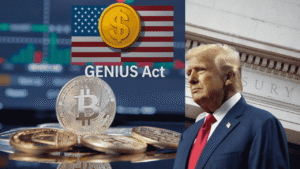America’s national debt has surpassed $37 trillion, raising alarms among economists, markets, and policy experts. While the U.S. debt has been a concern before, its rapid growth and the current economic climate make this milestone particularly significant.
Key Takeaways
- The U.S. national debt has crossed $37 trillion, with annual interest costs nearing $1.2 trillion, straining federal finances.
- Recent policies, including tariffs and new spending initiatives, add pressure to the debt-to-GDP ratio, which is now over 120%.
- Households and small businesses face higher borrowing costs and tighter credit, while markets monitor Treasury yields for signs of stress.
- Without a plan to manage debt growth, the U.S. risks reduced flexibility to handle future economic challenges.
The debt surge comes amid slower economic growth, rising interest costs, and new policy measures in Washington. Treasury data indicates that interest payments on the debt are approaching $1.2 trillion annually, nearly matching federal spending on defense. Economists warn that each new dollar borrowed increases the cost of servicing existing debt creating a growing problem.
Recent policies, such as tariffs and new spending programs, are adding to the debt burden at a time when the debt-to-GDP ratio is already at levels not seen since World War II. This article explores what this means for the economy, financial markets, and everyday households.
Table of Contents
Why the $37 Trillion Mark Matters for the U.S. Economy
The $37 trillion debt is more than a number, it signals challenges for the U.S.’s long-term financial health. According to Treasury and Congressional Budget Office (CBO) estimates, the debt-to-GDP ratio is now above 120%, a level considered risky for an economy that depends on global confidence to finance its borrowing.
Rising debt leaves the U.S. vulnerable to changes in interest rates. A one-point increase in borrowing costs could add hundreds of billions to annual interest payments. For context, when the debt was $10 trillion in 2008, interest costs were significantly lower due to smaller debt and lower rates.
Globally, the U.S. relies on foreign buyers, particularly from Asia and Europe, to purchase Treasury bonds. If foreign demand weakens or requires higher yields, domestic markets could face pressure. While Treasuries are still seen as safe assets, this confidence has limits.
The debt also creates a “crowding-out” effect, where federal borrowing competes with private investment for capital. This can slow economic growth, reduce productivity, and limit the government’s ability to respond to future crises. The $37 trillion mark highlights how little room remains for policy flexibility.
Table: U.S. Debt-to-GDP Trend and Interest Costs
Year | National Debt ($ Trillion) | Debt-to-GDP Ratio | Annual Interest Cost ($ Billion) |
2015 | 18.1 | 100% | 402 |
2020 | 27.7 | 126% | 523 |
2023 | 33.2 | 120% | 879 |
2025* | 37.0 | 121% | 1,150 |
2030* | 44.5 (Projected) | 124% | 1,600 |
Source: U.S. Treasury, CBO projections. Figures for 2025 and 2030 are estimates based on current trends
Tariffs, New Policies, and the Debt Burden
Recent policies are contributing to the debt challenge. Tariffs on imports from the EU, India, China, and other economies are expected to generate some revenue, but trade experts warn that reduced imports and potential retaliation could offset these gains. Tariffs act like a tax on trade, which can slow economic growth and limit tax revenue.
The new spending and tax package, referred to as a major fiscal initiative, includes tax credits, small business incentives, and infrastructure investments. Nonpartisan analysts estimate this could add trillions to the debt over the next decade. Tax credits for childcare, student loans, and small businesses reduce short-term revenue, while new spending commitments increase costs immediately.
Economists note that these policies could push the debt-to-GDP ratio higher, especially if economic growth slows or borrowing costs rise. The combination of tariffs and new spending tightens the fiscal squeeze at a time when the U.S. is already managing a historically high debt load.
“The U.S. can sustain high debt for years, but rising interest costs will increasingly limit budget flexibility for other priorities,” according to Moody’s Analytics.
How the Debt Crisis Affects Financial Markets
Markets are closely watching the rising debt. Treasury yields have been climbing due to inflation concerns and the volume of debt the government must finance. Higher yields can occur when investors demand greater returns for buying bonds, especially during large bond auctions.
Rising yields impact more than just government borrowing. Mortgage rates, auto loans, and corporate borrowing costs often follow Treasury yields, affecting consumers and businesses. This makes the national debt a market issue with real financial consequences.
Stock markets feel the effects too. Industries like homebuilding and small-cap growth companies, which rely on affordable credit, may struggle when borrowing costs rise. Conversely, banks and energy firms may benefit from higher yields and new trade-related opportunities.
Foreign investors, particularly Japan and China, who hold over $2 trillion in U.S. debt, play a key role. If their demand for Treasuries weakens due to geopolitical tensions or other factors, yields could rise further, increasing market volatility.
“Markets can handle a lot, but confidence isn’t infinite,” said a New York-based bond strategist. “Without a plan to slow debt growth, volatility could spike.”
How Households and Small Businesses Feel the Impact
For most Americans, the national debt feels distant until it affects their wallets. Higher interest rates, driven by government borrowing, mean costlier mortgages, car loans, and credit card payments.
Small businesses face similar challenges. Loans for equipment or expansion become more expensive in a high-debt, high-rate environment. Firms with tight margins, like local manufacturers or logistics providers, may delay growth or cut jobs if financing costs keep rising.
The debt also limits the government’s ability to respond to future economic downturns. If interest payments continue to climb—potentially exceeding $1.2 trillion by 2026—spending on relief programs, subsidies, or infrastructure could be reduced, or taxes could rise.
Inflation is another concern. While debt itself doesn’t directly cause price increases, large deficits paired with stimulus spending can drive demand in certain sectors, raising costs for groceries, school supplies, or home repairs.
For households and small businesses, the $37 trillion debt means higher borrowing costs, potential market swings, and tighter public finances that could limit future support.
What Policymakers and Investors Are Watching
In Washington, the $37 trillion debt is a growing political issue. Treasury officials are bracing for heavy bond issuance, and any drop in investor demand could increase borrowing costs. Lawmakers are split, with some calling for spending cuts and others pushing for more investment in infrastructure, defense, or social programs.
Investors are monitoring the Federal Reserve’s actions. If interest rates remain high to combat inflation while debt grows, interest payments could outpace federal revenue growth. CBO projections suggest interest costs could rival defense spending within a decade.
Foreign markets, especially Japan and China, are watching U.S. policy and politics closely. Any sign of fiscal instability could affect currency and equity markets globally creating a more volatile environment for investors.
“When interest payments near a trillion dollars a year, every market shock or recession becomes harder to manage,” said a Brookings Institution senior fellow.
A Slow-Moving Crisis That Needs Attention
Economists describe the debt situation as a slow-moving storm. It won’t cause immediate collapse, but the risks grow each year the debt outpaces economic growth. With high interest rates and new spending policies in place, the debt to GDP ratio will likely remain under pressure.
For households, this means higher borrowing costs, volatile prices and potentially less government support in the future. Small businesses may delay expansion while investors weigh the safety of Treasuries against long-term fiscal challenges.
The U.S. economy remains resilient but the $37 trillion debt leaves less room to handle unexpected shocks. Policymakers must decide whether to cut spending, increase revenue, or accept tighter markets and limited flexibility. For now, confidence keeps the system running but confidence alone is not enough.
“The U.S. benefits from issuing the world’s reserve currency, but unchecked debt growth without a plan will test global investor trust,” according to the IMF.
Related Articles

US–EU Trade Deal Brings 15% Tariff on Imports: What It Means for Businesses, Consumers, and Investors

Historic US–EU Trade Deal Slaps 15% Tariff on EU Imports: Who Wins and Who Loses?

India, UK Sign Landmark Free Trade Agreement: 99% Tariff Free Access, Visa Boost, $34 Billion Trade Surge Expected

Fed Governor Waller Pushes for July Rate Cut Amid Internal FOMC Split

Trump Signs GENIUS Act Into Law, Setting First Federal Stablecoin Rules

Trump Signs One Big Beautiful Bill into Law: Here’s Why It Matters You
Build Investor-Ready Financial Models
Impress stakeholders with reliable, easy-to-read models built by experts.
>> Explore Now
Understand & Manage Your Business Finances Smarter
Explore key tools and guides on leverage, ratios, and capital.
You Might Also Like
In our commitment to ensuring accuracy and credibility, we prioritize the use of primary sources to support our reporting. This includes white papers, government data, original reporting, and interviews with industry experts. We also reference original research and findings from reputable publishers when appropriate. We always ensure that proper attributions and citations are provided with source links, within the article itself, to uphold transparency and fair practice. To learn more about the standards we uphold in producing accurate and unbiased content, please refer to our Editorial Policy & Guidelines.














